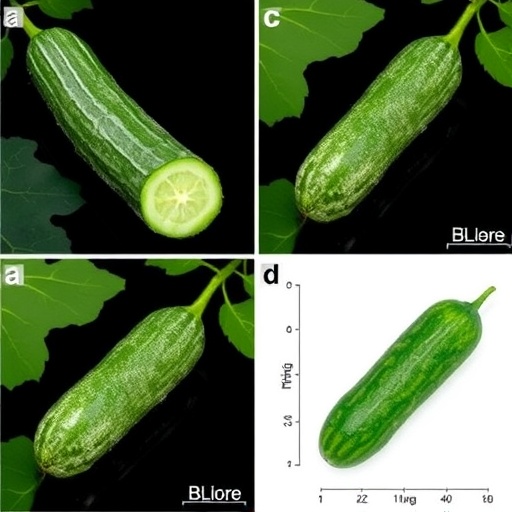In a groundbreaking study published in the “Environmental Science and Pollution Research,” researchers Hosseini and Mahdavi delve into the residue dynamics of isocycloseram, a pesticide widely used in agricultural practices, and its primary metabolite in cucumbers. The significance of this research cannot be overstated, as it addresses the pressing concern over pesticide residues in food products—an issue that affects not only consumer safety but also ecological health.
Cucumbers, a staple in many diets, are particularly susceptible to pesticide contamination due to their agricultural practices. Most notably, isocycloseram has gained attention for its effectiveness in controlling pest populations while raising questions about its persistence in crop produce. The researchers meticulously dissect the behavioral patterns of isocycloseram and its metabolite, providing critical data on how varying application doses, peeling methods, and repeated use influence residue levels.
One of the most compelling aspects of this research is its experimental design. Through a systematic approach, the authors applied varying dosages of isocycloseram to cucumber plants, allowing for an extensive analysis of residue concentrations over time. This methodology is essential in determining how long the pesticide remains on the surface and within the fruit, thereby delivering key insights into safe consumption levels and the potential risks associated with dietary exposure.
Peeling cucumbers is a common practice that many assume mitigates pesticide exposure. In their research, Hosseini and Mahdavi explore this theory in depth. Their findings reveal that peeling does indeed have an impact on residue removal, but its effectiveness is closely tied to the concentration of isocycloseram used and the timing of the application relative to harvest. This nuanced understanding challenges existing consumer assumptions and emphasizes the importance of informed food preparation methods.
Repeated applications of isocycloseram are also scrutinized within this study. Typically, agricultural practices involve multiple treatments to ensure pest control. However, Hosseini and Mahdavi provide evidence suggesting that repeated applications can lead to increased residue accumulation, raising alarms about long-term exposure risks. These findings are particularly crucial as they initiate discussions on regulatory policies governing pesticide use in food production.
The implications of this research extend beyond cucumbers. With the agricultural sector continually seeking efficient pest management solutions, the insights gained regarding isocycloseram residue dynamics are pertinent for a broader range of crops. The study serves as a pivotal reference point for future investigations into pesticide safety, encouraging an interdisciplinary approach that includes toxicology, environmental science, and public health considerations.
As consumers become more informed about food safety, the need for transparency in agricultural practices is paramount. This research not only highlights the potential risks associated with pesticide residues but also underscores the responsibility of producers and regulatory bodies to ensure food safety through clear guidelines. Given the vital role that cucumbers play in diets worldwide, it is essential that stakeholders are educated about the impact of agricultural practices on food quality and safety.
Moreover, the study ignites a conversation about alternative pest management strategies. With growing concerns over pesticide resistance and ecological impacts, research like this prompts exploration of integrated pest management (IPM) strategies, which prioritize sustainable practices. By providing evidence-based recommendations for pesticide use, the authors contribute to the ongoing discourse about the balance between effective pest control and consumer safety.
As global awareness of pesticide-related issues increases, this study emerges as a vital contribution to the field of environmental science. It showcases the complex interactions between agricultural practices and food safety while emphasizing the necessity for continued research in this area. The rigorous examination of isocycloseram serves as a reminder that scientific inquiry remains critical to addressing global challenges in agriculture, health, and the environment.
In conclusion, the research conducted by Hosseini and Mahdavi reflects a significant stride toward understanding pesticide dynamics in crops. By shedding light on the residue behavior of isocycloseram in cucumbers, the study empowers stakeholders across various sectors—from farmers to consumers—to make informed decisions regarding agricultural practices. The call for transparency and safety in our food systems is more urgent than ever, and this research contributes meaningfully to that dialogue, illuminating pathways for future exploration and policy development.
As the agricultural community grapples with the challenges posed by pests, it is paramount that studies like this one guide practices that prioritize both crop yield and consumer health. Understanding the residue dynamics of isocycloseram not only informs safer consumption practices but also fosters a broader commitment to sustainable agriculture. The convergence of science, policy, and public awareness is crucial as we move towards solutions that balance agricultural productivity with the safety of the foods we consume every day.
Ultimately, the findings of this research are a clarion call for vigilance in agricultural practices. As we progress further into an age defined by scientific advancements and increased scrutiny of our food systems, the importance of studies like that of Hosseini and Mahdavi will only continue to grow, ensuring that safety, health, and environmental stewardship remain at the forefront of agricultural innovation.
Subject of Research: Residue dynamics of isocycloseram in cucumbers
Article Title: Residue dynamics of isocycloseram and its main metabolite in cucumber: effect of dose, peeling, and repeated application
Article References:
Hosseini, M., Mahdavi, V. Residue dynamics of isocycloseram and its main metabolite in cucumber: effect of dose, peeling, and repeated application.
Environ Sci Pollut Res (2025). https://doi.org/10.1007/s11356-025-37205-6
Image Credits: AI Generated
DOI: https://doi.org/10.1007/s11356-025-37205-6
Keywords: isocycloseram, pesticide residues, cucumber, food safety, environmental science, agricultural practices




